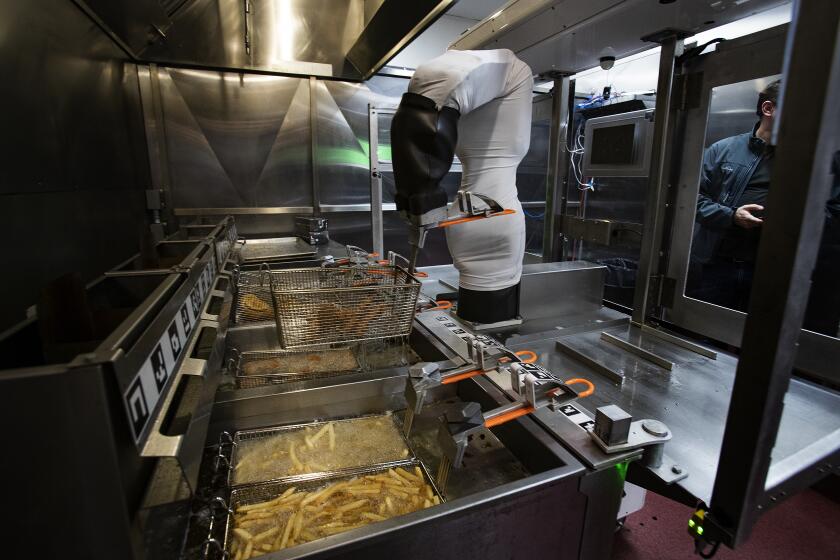Is California’s high-speed train on track or off the rails?
One political party absolutely loves the idea of the modern rail system, both as a boon for business and commerce, and, incidentally, perhaps as a bit of a boondoggle for its political buddies.
Guess which party.
It’s the GOP, 150 years ago. The rail system I’m talking about is the railroad to the Pacific. It was a very wide plank in the Republican Party platform in 1856 and 1860, and a dream of Abraham Lincoln’s that he never lived to see realized.
LETTERS TO THE EDITOR: Bullet train blues
Now it’s the Democrats in California – and not even all of them -- who want high-speed rail, and barely enough of them in the Legislature just cast the votes to make it happen.
The Democratic state senator from Palo Alto, Joe Simitian, was asking the right questions when he, a longtime booster of California high-speed rail, changed his mind, and his vote, to a “no” on the current version, which would run for 800 miles at a top speed of 220 miles an hour. It doesn’t make sense, he argued – as much to himself as to his colleagues – to issue those bonds and move forward when the state is on shaky fiscal legs, when, as The Times reported, one in six Californians isn’t certain where his or her next meal is coming from. Where, asked another Democratic legislator, Long Beach Sen. Alan Lowenthal, is the money?
Four years ago, California voters approved bond measures for about $10 billion to start up the high-speed rail project, the cost of which is now pegged at $68 billion. Ask voters the same thing today, according to the Field Poll, and they’d say no.
Is there ever a perfect time to undertake these projects? Congress passed the Pacific Railway Act in 1862, the second year of the Civil War. How’s that for timing?
Let’s say high-speed rail moves forward. Will some of that $68 billion slip through the cracks? Probably. It often does in such undertakings, and not just the ‘’big government’’ ones. Recall the mind-bogglingly expensive Iraq war, which was mind-bogglingly expensive in part because of the money being pumped into private contractors’ pockets? Neither we nor the Iraqis got anything as useful or enduring as a railroad out of that.
Whistleblowers’ statements to Congress showed the stupefyingly flagrant picking of the public pocket by private contractors. Sen. Dick Durbin, the Illinois Democrat, cited instances of contractor Halliburton and its subsidiaries “driving empty trucks back and forth while billing the federal government for each trip; charging the taxpayers for 240,000 cases of soda instead of the 240,000 cans they actually delivered; abandoning $85,000 vehicles by the side of the road when they got flat tires rather than making repairs because each truck was just another cost-plus item on a federal contract.”
Knowing all of that, why can’t the project do the obvious thing and build in stern fiscal protections along with the train system itself? Shouldn’t it actually be easier to appoint watchdogs and fiscal overseers, and audit, audit, audit, when it’s public money is being spent in public? If high-speed rail does hit the ground, can’t Simitian and his colleagues insist upon it?
After the Northridge earthquake broke the Santa Monica Freeway, the city and the state, under Mayor Richard Riordan and Gov. Pete Wilson, both Republicans, got it fixed ahead of time by promising the contractor a bonus for finishing early. Why couldn’t verifiable incentives like that, and not the Halliburton outrages, work for high-speed rail?
The battle already has been joined over environmental clearances, routes, construction start-points; by all means, duke it out in the open over every last mile. Let us see and know what’s being done in our name. That’s what should be happening in the cut and thrust of this process, but it shouldn’t paralyze the process itself.
The 19th century’s trans-national railway project was rife with fraud and graft that are positively criminal today, from the bribes that railroad men spread over Capitol Hill to this, my favorite scam, as detailed in H.W. Brands’ wonderful book “American Colossus.”
The federal government subsidized the project with loans – bonds – and land grants. For each “easy mile” of construction at the eastern and western ends, companies would get $16,000 in bonds. Once the going got steeper, the subsidy went to $32,000 a mile and, to cross the Sierra Nevadas, $48,000 a mile.
But here’s one of the slickest bits of business, one that makes the Iraq contractors’ cost-plus schemes look crude by comparison. As Brands writes: “The original law allowed greater compensation to the railroads for track laid in the mountains, but it didn’t specify where the mountains began.” So Leland Stanford, one of the Big Four moguls and, incidentally, California’s governor, got a team of geologists to say that the Sierra Nevadas actually began in the Sacramento Valley, and each mile was price-jacked up accordingly. Even Honest Abe Lincoln had to agree with the politics, if not the geology, and a California Republican congressman reported back to Stanford that his persistence and Lincoln’s faith “moved mountains.”
That’s a sharp piece of work, but as Brands’ book points out, the railroad would not have happened at all without government funding – which is precisely the point being made about high-speed rail today. “Private capital markets couldn’t attract investors willing to hazard such large sums … on such a distant payoff” at least a decade away.
American business doesn’t like to wait 10 years for a payoff, but sometimes that’s the only way that big things can happen. Payoffs don’t show up only on a quarterly profits sheet. American business wouldn’t have built the interstate highway system – its rewards to commerce and to the nation, in ways perceptible and imperceptible, have been immense, but not immediate enough for any impatient CEO. But the country wouldn’t be the nation it is without it.
High-speed rail could wind up as a techno-evolutionary dead end, or it could be a model for the nation, one for which future Californians will bless us.
That’s why government undertakes big, important, useful things: because no one else can, or will.
As for high-speed rail, in a way, there’s no wrong vote on it, and no right vote, either, except through the rear-view mirror of history, when people either will be lionized or reviled for their decisions. And there are perfectly sound reasons for legislators to vote either way. But none of those reasons should be a timidity of ambition or narrowness of vision.
ALSO:
Just saying “non” to French high-speed rail help
Has California blown its chance to save money on high-speed rail?
More to Read
A cure for the common opinion
Get thought-provoking perspectives with our weekly newsletter.
You may occasionally receive promotional content from the Los Angeles Times.







